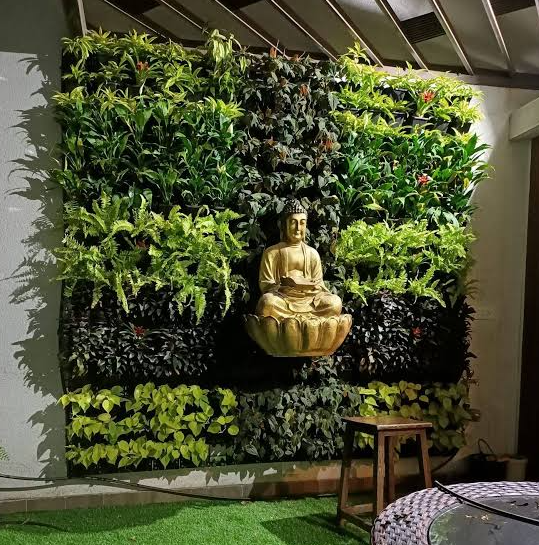Creating Eco-Friendly Living Fences to Enhance Privacy and Biodiversity
- Anu Dev
- Apr 29
- 4 min read
In an age where urban living often overshadows our connection to nature, many people are exploring sustainable solutions to enrich their outdoor spaces. One such solution is the creation of living fences. These unique structures not only provide privacy but also invite wildlife, increasing local biodiversity. By using a blend of native plants, living fences deliver both functionality and ecological benefits, making them an attractive option for homeowners.
What Are Living Fences?
Living fences are hedgerows crafted from various plant species, typically those native to the surrounding area. Unlike traditional barriers made from wood, metal, or vinyl, living fences foster a natural boundary that harmonizes with the environment. Homeowners can customize these fences to reflect their personal style while serving practical roles, such as defining property lines, protecting gardens, and enhancing privacy.
Benefits of Living Fences
Privacy and Security
Privacy is a top priority for many homeowners. Dense, thriving vegetation provides a natural screen that prevents outsiders from viewing personal spaces. For example, a living fence with a mix of 6-foot hawthorn and elderberry plants can obstruct views while still allowing airflow and sunlight to filter through. This means you can have your quiet space without sacrificing the benefits of fresh air and light.
Biodiversity Support
Living fences play a crucial role in enhancing local ecosystems. Using a variety of native plants, these fences provide habitats for various species, from birds to beneficial insects. For instance, a living fence featuring elderberry and native grasses can draw in more than 15 different bird species and numerous pollinators, which are essential for maintaining a balanced environment. Native plants are best suited to local climates, often thriving with little care. They not only support wildlife but also contribute to a robust ecosystem.
Aesthetic Appeal
A well-designed living fence can dramatically improve the look of any property. By choosing the right mix of plants, homeowners can create a vibrant tapestry throughout the seasons. For example, consider planting colorful flowering dogwoods in spring, fragrant honeysuckles in summer, and deciduous shrubs that showcase rich autumn colors. This diversity offers visual interest year-round, enhancing views from all angles.
Eco-Friendly Solutions
Choosing living fences is an environmentally friendly decision. These natural barriers help purify the air by absorbing carbon dioxide and releasing oxygen. Studies indicate that regions with more greenery benefit from a 20% improvement in air quality. Moreover, living fences can reduce soil erosion and retain moisture, which is especially important in drought-prone areas. Furthermore, native plants typically require less water, fertilizer, and pesticides, creating a healthier environment.
Choosing the Right Plants
Native Species Selection
Selecting the right native plants is vital when establishing a living fence. Native species are adapted to local conditions, ensuring they flourish with minimal maintenance. They are more appealing to local wildlife, which is essential for promoting biodiversity. Some effective native plants to consider include:
Hawthorn (Crataegus): Offers dense foliage and attracts wildlife with its berries.
Elderberry (Sambucus): Known for its edible fruits, which draw birds and other animals.
Native Grasses: Varieties like switchgrass and big bluestem can deter intruders and add visual interest.
To maximize your living fence’s success, prioritize plants that thrive in your local climate and soil type. Consulting local horticulturists or native plant societies can provide insights tailored to your region.
Designing Your Living Fence
Designing a living fence requires thoughtful planning beyond plant selection. Here are some tips for creating an effective layout:
Layering: Place taller plants at the back and shorter ones in the front. This arrangement offers both privacy and visual appeal, featuring varied heights for wildlife.
Mixing Plants: Combine flowering plants, shrubs, and grasses to create a more dynamic garden. This diversity not only looks better but also supports different habitats.
Spacing: Ensure adequate spacing between plants to allow room for growth. Research the mature size of each species to avoid overcrowding.
Seasonal Varieties: Select plants that bloom at different times of the year for consistent beauty and food sources for pollinators.
Maintenance Tips
Though living fences require less upkeep than traditional fences, some maintenance is still needed. Here are key practices to keep your living fence thriving:
Watering: Newly planted species need regular watering to establish roots. Once they are settled, many native plants will require far less water, making them low-maintenance.
Pruning: Regular pruning helps maintain their shape and encourages healthy growth.
Weed Control: Watch for invasive species that might compete with your native plants. Removing these weeds early is vital for protecting your living fence.
Reconnecting to Nature
Living fences offer homeowners an innovative way to enhance privacy while positively impacting the environment. By integrating native plants, these eco-friendly barriers enrich the local ecosystem and create captivating landscapes.
Implementing a living fence not only beautifies your property but also fosters local wildlife habitats. This initiative supports biodiversity while enriching your experience with nature. As urbanization continues to challenge our connection to the natural world, exploring living fences can be a valuable step towards sustainability in your own backyard.

$50
Product Title sample
Product Details goes here with the simple product description and more information can be seen by clicking the see more button. Product Details goes here with the simple product description and more information can be seen by clicking the see more button

$50
Product Title
Product Details goes here with the simple product description and more information can be seen by clicking the see more button. Product Details goes here with the simple product description and more information can be seen by clicking the see more button.







Comments